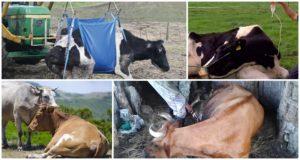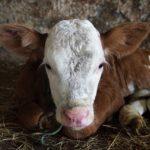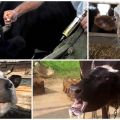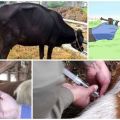Symptoms of anaplasmosis in cattle and diagnosis, methods of treatment and prevention
The development of cattle anaplasmosis is quite common and can cause serious harm to animal health. The disease rarely provokes death, but it has a severe course. Dealing with it can be quite difficult. Therefore, the fight against the disease is recommended to be combined with preventive measures that are aimed at preventing re-infection.
What is anaplasmosis: pathogens and vectors
This term is understood as a pathology that is carried by small microorganisms. Their dimensions are 0.2-2.2 microns. They enter the red blood cells and multiply there. Anaplasmas cause metabolic disturbances and impair oxygen distribution in the body. This causes the development of anemia in animals.
Zones and conditions of infection spread
This pathology is widespread. Intracellular bacteria are considered its causative agents. Parasites form colonies and reproduce by dividing or budding. Bacteria can be carried by mosquitoes, ixodid ticks, horseflies. They are also distributed by biting midges, midges, and flies. Sometimes infection occurs through infected tools. The peak incidence occurs in the spring and summer - it is during this period that the vectors of pathology wake up and become active.
Features of the development of the parasite
Anaplasmas are parasites with two hosts. They absorb nutrients from the blood of cattle. However, from one individual to another, they spread with the help of various insects. When a carrier of pathology sticks to an animal, dangerous bacteria enter its bloodstream.
Some time after infection, anaplasma begins to actively develop in blood cells - most often in erythrocytes. Although sometimes they also penetrate platelets and leukocytes. As a result, after a few days, whole colonies are formed in the blood of animals. Bacteria multiply by budding or dividing.

Bacterial microorganisms enter the body of ticks or other insects while sucking the blood of infected individuals. In the body of insects, pests mainly multiply in the intestines and malpighian vessels. From there they can be passed on to offspring.
Signs and symptoms of infection
The key manifestations of the pathology are associated with blood clotting disorders. At the same time, the following signs prevail in cattle:
- a sharp increase in body temperature;
- a change in the shade of the mucous membranes - an excess amount of bilirubin in the blood of infected animals causes yellowing of the membranes;
- increased heart rate;
- heavy intermittent breathing due to oxygen starvation;
- loss of appetite;
- cough;
- problems in the work of the digestive organs;
- physical exhaustion, rapid weight loss;
- general weakness and apathy;
- decrease in milk yield;
- swelling in the limbs and in the chest area - observed in advanced cases;
- general weakness;
- anemia;
- convulsions;
- fever;
- miscarriages in pregnant individuals;
- sterility in males.
As an additional feature, a change in the eating habits of sick individuals can be designated. Due to metabolic disorders, animals may try to eat inedible items. With a chronic course of the disease, intermittent fever occurs. In animals, body weight decreases, hypotension of the digestive tract is observed. The mucous membranes remain pale.
Diagnosing the problem
It can be quite difficult to identify pathology. Its manifestations largely coincide with other diseases, which creates difficulties in diagnosis. In such a situation, there is a risk of choosing the wrong therapy regimen.
Most often, pathology is confused with the following disorders:
- piroplasmosis;
- babesiosis;
- leptospirosis;
- anthrax;
- theileriosis.
In order to make an accurate diagnosis, it is recommended to conduct laboratory tests of the blood smear of the infected animal.

How to treat anaplasmosis in cattle
At the first symptoms of anaplasmosis in cattle, it is recommended to isolate the infected animal from the rest of the livestock. In this case, it is important to confirm the diagnosis and choose a treatment. To cope with the disease, a whole range of medicines is used. The most commonly prescribed drugs are:
- "Terramycin", "Tetracycline", "Morphycline" - they are recommended to be mixed with a solution of novocaine with a concentration of 2% and administered intramuscularly. It is recommended to introduce 5-10 thousand units of the drug per 1 kilogram of body weight. The drug should be used for 4-6 days.
- Oxytetracycline-200 is a long-acting drug. It must be administered 1 time per day at intervals of 4 days.
- "Sulfapyridazine-Sodium" - this product is recommended to be mixed with distilled water in a ratio of 1:10. For 1 kilogram of weight, you need to use 0.05 grams of the product. It is recommended to apply it for 3 days.
- "Biomycin" - it is recommended to use 10 milligrams of funds per 1 kilogram of body weight. This must be done for 7 days.
- "Ethacridine lactate" - 200 milligrams of the product is recommended to be mixed with 60 milliliters of medical alcohol and 120 milliliters of distilled water. The composition must be administered once a day.
For symptomatic treatment, it is recommended to use antipyretics and analgesics. Animals with this diagnosis suffer from metabolic disorders in the body. Therefore, they definitely need to provide a dietary diet. The menu should be based on juicy greens. Drinking plenty of fluids is also important.
In the cold season, the development of anaplasmosis is caused by a lack of vitamins and minerals in animal feed. In this case, the disease itself provokes a metabolic disorder. Therefore, it is so important to give pets vitamin and mineral supplements. Be sure to use the following substances:
- phosphorus, calcium, vitamin D - a deficiency of these substances provokes a deterioration in appetite, makes animals shy and causes developmental delays;
- copper - should be a must in any balanced diet;
- manganese, vitamin A, cobalt - a lack of these substances causes digestive problems and leads to exhaustion;
- zinc, iodine - the lack of these elements provokes a decrease in milk yield;
- vitamin E - a deficiency of this element often provokes anemia and even dystrophy.
Potential danger
With the development of anaplasmosis, severe anemia syndrome often occurs. A significant decrease in the volume of erythrocytes in the body leads to its appearance. In this case, the parameters are restored extremely slowly. The painful process has a long course.
Despite the complex course of the pathology, it rarely causes death. This is due to the biological characteristics of the parasites - first of all, their virulent properties.
How to prevent the onset of the disease
To minimize the risk of developing pathology, it is recommended to engage in prevention.
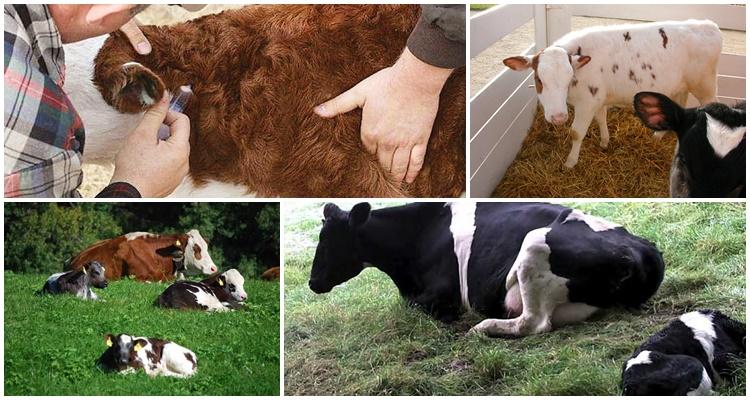
In this case, the following rules should be observed:
- Monitor the condition of pastures for grazing animals.
- Quarantine new individuals. It should last 1 month. During this period, diagnostic examinations should be performed to help make sure that there are no parasites.
- Periodically treat animal hair with acaricides. The procedure is recommended to be performed weekly.
- Isolate sick individuals from the rest of the livestock in a timely manner.
- When buying animals, be sure to check the veterinary certificate.
- Systematically disinfect the rooms where pets live.
There are also special vaccines that help develop immunity to the causative agents of anaplasmosis. This protects animals from the development of the disease for 10-11 months.
Anaplasmosis is considered a dangerous disease that often occurs in cattle. It is provoked by microscopic parasites that lead to the development of anemia. This causes various problems in animals. Therefore, at the first symptoms of a violation, it is recommended to contact a veterinarian.



